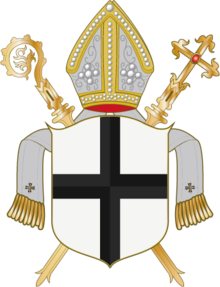Diocese of Fulda
|
Diocese of Fulda Dioecesis Fuldensis Bistum Fulda |
|
|---|---|

|
|

Coat of arms
|
|
| Location | |
| Country | Germany |
| Ecclesiastical province | Paderborn |
| Metropolitan | Paderborn |
| Deaneries | 10 |
| Subdivisions | 43 pastoral areas |
| Statistics | |
| Area | 10,318 km2 (3,984 sq mi) |
| Population - Total - Catholics |
(as of 31 December 2014) 1,688,351 397,227 (23.5%) |
| Parishes | 299 |
| Information | |
| Denomination | Roman Catholic |
| Rite | Latin Rite |
| Established | 5 October 1752 |
| Cathedral | Fulda Cathedral |
| Patron saint |
Saint Boniface main patron Saint Elisabeth second patron |
| Secular priests | 271 |
| Current leadership | |
| Pope | Francis |
| Bishop | Heinz Josef Algermissen |
| Auxiliary Bishops | Karlheinz Diez |
| Vicar General | Gerhard Stanke |
| Emeritus Bishops | Johannes Kapp (Auxiliary Bishop) |
| Map | |
 Current extent of the Diocese |
|
| Website | |
| bistum-fulda.de | |
The Diocese of Fulda (Latin Dioecesis Fuldensis) is a Roman Catholic diocese in the north of the German state of Hessen. It is a suffragan diocese of the Archdiocese of Paderborn. The bishop's seat is in Fulda Cathedral.
The history of the Diocese of Fulda goes back to the founding of a monastery by Saint Boniface in 744. Boniface named Saint Sturm the abbot of the monastery.
On 4 November 751, Pope Zachary decreed that the monastery would not be under the control of any diocese but rather directly under the Pope. This special relationship with Rome is illustrated still today in the statue of Saint Peter that stands in the Cathedral. Because Boniface's expressly requested that his body be taken to Fulda after his death (rather than to Mainz or Utrecht), the area became a popular destination for pilgrims. Boniface, along with Sturm, were named the patron saints of the monastery and later of the diocese.
Through gifts and donations, the monastery's influence grew ever stronger in the following centuries. Under Rabanus Maurus in the 9th century, the monastery became the scientific center of the Holy Roman Empire.
In 1220, the abbey was elevated to an abbey-principality by Frederick II. In 1571, Jesuits settled in Fulda and made a considerable contribution to the efforts of the Counter-Reformation.
...
Wikipedia
